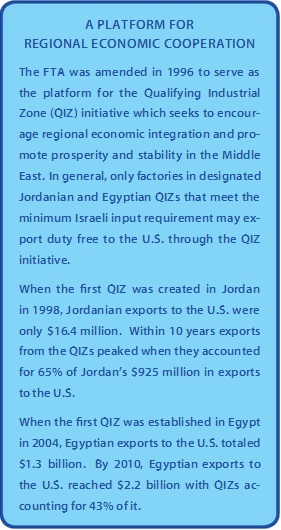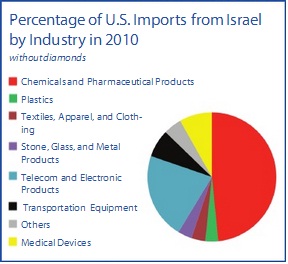On April 22, 1985, the United States Trade Representative and the Israeli Minister of Industry and Trade signed the U.S.-Israel Free Trade Agreement (FTA). The FTA was the U.S.’s first bilateral free trade agreement and Israel’s second (following Israel’s free trade agreement with the European Community, which was signed in 1975).

The Agreement entered into force in September 1985 after it was approved by the U.S. House of Representatives by a 422-0 vote and by a voice vote in the U.S. Senate. In his remarks after the FTA was signed, President Ronald Reagan said that “the Free Trade Area Agreement symbolizes once again our two countries’ deep community of interest and our shared values and aspirations for a better future. It underscores the importance of Israel to the United States as an ally, as a trading partner, and as a friend.”
Prior to the FTA, Israel benefitted from the Generalized System of Preferences (GSP), which is a unilateral trade preference program that allows goods from developing countries to enter the U.S. duty free. In addition, beginning in the early 1970’s, Israel was a recipient of U.S. economic aid. The FTA resulted in the mutual liberalization of bilateral trade and the eventual elimination of U.S. economic aid to Israel.
Under the FTA, the U.S. and Israel implemented phased tariff reductions culminating in the

complete elimination of duties on manufactured goods on January 1, 1995. The FTA permitted the U.S. and Israel to maintain certain import restrictions, such as quantitative restrictions and fees, other than customs duties, on agricultural products based on agricultural policy considerations. Nonetheless, over 90% of U.S. agricultural exports by value enter Israel duty free.
To qualify for preferential treatment under the FTA, manufactured goods must be (1) grown, produced, or manufactured entirely in the U.S. or Israel or (2) substantially transformed in the U.S. or Israel and contain at least 35% U.S./Israeli content. To meet the35% content requirement, up to 15% of the product’s value may originate in the other country so long as the input complies with the FTA’s rules of origin. Goods must also be shipped directly from one country to the other.
The FTA, despite being over twenty-five years old and only twenty pages long, provides a stable business environment and a flexible platform to further enhance the commercial relationship. The FTA established a bilateral Joint Committee (JC) in order to provide a structure for discussing the enhancement of trade and issues of mutual concern. The JC meets annually and is headed by USTR and the Foreign Trade Administration of Israel’s Ministry of Industry, Trade, and Labor. The JC’s broad mandate has provided the forum to further liberalize trade in agricultural products and establish cooperation on standardization.
What Happened Next?The United States–Israel Standardization Dialogue was established in 2007 to create a forum for

the two governments and standardization bodies to work together on issues such as product standards, testing, labeling, and certification requirements in order to facilitate and further enhance trade.
On October 18, 2010 the U.S. and Israel announced a decision to create a work plan to ensure the benefit so the economic relationship are further shared and sustainable. The work plan will aim to enhance regulatory cooperation and seek to further liberalize trade in agriculture and services. As initial steps under the work plan, the parties agreed to pursue negotiations towards implementation of a Mutual Recognition Agreement for conformity assessment of telecommunications equipment and to explore ways to facilitate trade by looking at the relevant customs procedures and regulations.
Both countries benefitted, and continue to benefit, from the FTA, as evidenced by the exponential

growth of the U.S.-Israel economic relationship since its signing in 1985. Between 1984 and 1996, one year after the FTA was fully implemented and ten years after it was signed, bilateral trade in goods more than tripled from $3.9 billion to $12.4 billion, with U.S. exports to Israel totaling $6 billion and Israeli exports to the U.S. totaling $6.4 billion. Between 1996 and 2010, bilateral trade in goods nearly tripled reaching $32.3billion. In general, about 50% of bilateral economic exchanges are concentrated in trade in goods; 30% are in investment; and 20% in trade in services.
In 2010, bilateral trade has started to rebound from the global economic downturn and is up about 13% as compared to 2009 with U.S. exports to Israel up 18% and Israeli exports to the U.S. up 12%. Bilateral trade reached $32.3 billion in 2010 with Israeli ex-ports to the U.S. totaling $21 billion and U.S. exports to Israel totaling $11.3 billion.
Who Benefits?
The majority of bilateral trade in goods, excluding diamonds, is concentrated in industrial and high tech items; for example, in 2010, chemicals and pharmaceutical products, plastics, telecommunications, transportation equipment, and electronic products accounted for nearly 78% of Israeli exports to the U.S. Similarly, chemicals and pharmaceutical products, plastics, transportation equipment, and telecommunications equipment and electronic products accounted for nearly 65% of U.S. exports to Israel.
The FTA has served as the platform to spur significant levels of bilateral foreign direct investment (FDI). Between 2000 and 2009, U.S. direct investment in Israel totaled $77.2 billion and Israeli direct investment in the U.S. totaled $51.3 billion. In 2009, Israel was among the top 20 suppliers of FDI to the U.S. in terms of total and per capita investments. These investments have created and support tens of thousands of jobs in both countries.
Israeli companies such as Teva Pharmaceuticals, Tower Semi Conductors, and Strauss are heavily invested in the U.S. and operate pharmaceutical, medical device, high-tech, homeland-security and defense plants throughout the country. Well known U.S. companies such as Microsoft, Google, IBM, Intel and Motorola have established major research and development facilities in Israel. Furthermore, Warren Buffet’s first foreign acquisition was a $4 billion investment in the Israeli tool manufacturer Iscar.
Over the last several decades numerous bilateral business organizations seeking to advance and strengthen U.S.-Israel commercial relations were established throughout the U.S. at the state and regional level. In October 2010 the U.S. Chamber of Commerce in cooperation with the Israel America Chamber of Commerce and the Israeli Ministry of Industry, Trade and Labor launched the U.S-Israel Business Initiative. The nationwide initiative seeks to bring together high-level American and Israeli government officials, business leaders, entrepreneurs, and innovators in a national forum in order to advance and strengthen U.S.-Israeli commercial relations.
 More Information on Trade and Investment in Israel
More Information on Trade and Investment in Israel